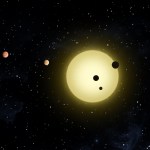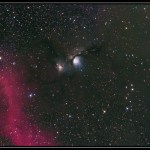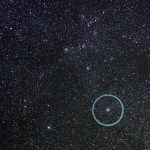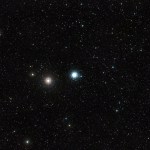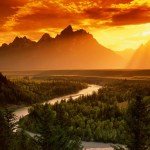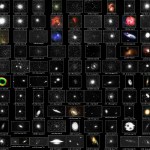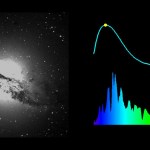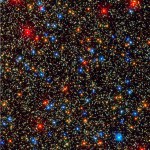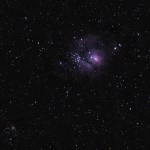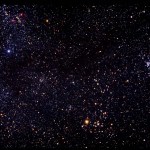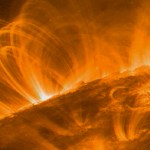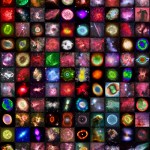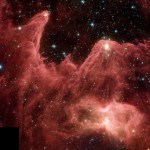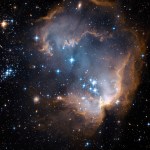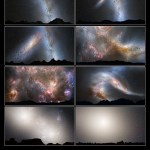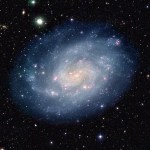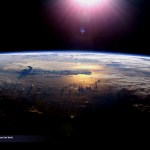Stars
"Death comes to all, but great achievements build a monument which shall endure until the sun grows cold." -Ralph Waldo Emerson
In the great cosmic ocean, there's only one planet that we know -- for certain -- has the right conditions and history to result in intelligent life: our own.
Image credit: NASA, from the Space Shuttle, for Sun-Earth Day 2008.
Life -- or even intelligent life -- may be possible in environments vastly different than our own: around different classes of stars, at different temperatures, and even with different molecules and/or chemical elements.
But we know…
"My role in society, or any artist's or poet's role, is to try and express what we all feel. Not to tell people how to feel. Not as a preacher, not as a leader, but as a reflection of us all." -John Lennon
Welcome to the latest edition of Messier Monday, where each week we take an in-depth look at one of the 110 deep-sky objects in the Messier Catalog. These objects, all of which are visible from certain northern latitudes at certain times of the year, were catalogued explicitly to prevent comet-hunters from confusing these static objects with potential comets.
Image credit: SEDS Messier…
"Who is wise? He that learns from everyone.
Who is powerful? He that governs his passions.
Who is rich? He that is content.
Who is that? Nobody." -Benjamin Franklin
Welcome to Messier Monday, where each week we take a journey into one of the 110 objects in the Messier Catalogue of non-cometary deep-sky objects. Ranging from stellar remnants to star clusters to globular clusters to distant galaxies and more, the Messier objects tell a rich and varied story that you can share in yourself through even the simplest of astronomical instruments.
Image credit: Rich Richins, of all 110 Messier…
"A truly good book teaches me better than to read it. I must soon lay it down, and commence living on its hint. What I began by reading, I must finish by acting." -Henry David Thoreau
Every day that we have free or leisure time, there's this great conflict as to how we spend it: working to better ourselves and improve our knowledge, and taking the time to enjoy our lives in whatever way we see fit. Sometimes, this goes horribly awry, as the B-52s would attest in their (relatively) new song,
Funplex.
But there's often no better way to combine these two pursuits than by reading a good book.…
"The man's a born straggler... another lucky exception to the rules of natural selection. A million years ago he would've been an easy snack for a saber-toothed tiger." -Carl Hiaasen
Welcome to the latest Messier Monday, where each week we take a look at one of Charles Messier's original catalogue of 110 deep-sky objects that comet-hunters might easily confuse with those transient passers-by in our Solar System.
Image credit: Greg Scheckler, from his 2008 Messier marathon, where he nabbed 105/110.
Quite to the contrary, each of the 110 objects in the Messier catalogue are (semi-)permanent…
“We live in an atmosphere of shame. We are ashamed of everything that is real about us; ashamed of ourselves, of our relatives, of our incomes, of our accents, of our opinions, of our experience, just as we are ashamed of our naked skins.” -George Bernard Shaw
All that is real about ourselves is nothing to be ashamed about; quite to the contrary, it's something to be eminently thankful for. This very existence is all we have, and while it's minuscule compared to the entire Universe, it required the entire Universe to bring us to the point where it's possible for us to exist.
What do…
"When your friends begin to flatter you on how young you look, it's a sure sign you're getting old." -Mark Twain
Welcome to yet another installment of Messier Monday, where each week, I'll pick one of the 110 Messier Objects -- deep-sky objects catalogued to avoid confusion for comet hunters -- to highlight for you.
Image(s) credit: SEDS -- http://messier.seds.org/.
So far, we've taken a look at a supernova remnant, a young open star cluster, and an active star-forming nebula, a testament to the great diversity of these faint, fuzzy objects that might be easily confused with a…
"You have to have a canon so the next generation can come along and explode it." -Henry Louis Gates
When it comes to stars, their fates are very well known. Every single star that's massive enough to fuse hydrogen into helium in its core will someday run out of fuel and die.
Image credit: NASA, ESA, F. Paresce, R. O'Connell, & the HST WFC3 Science Oversight Committee.
The very brightest and most massive stars -- about 1-in-800 of all stars -- will die in a spectacular, core-collapse supernova when their core burns fuel all the way through iron and finally runs out of room to go.
This…
"It's a brilliant surface in that sunlight." - Neil Armstrong
Indeed, all that glitters so brilliantly in the cosmos does so because of the stars that have formed throughout it.
Image credit: NASA, ESA, and the Hubble SM4 ERO Team.
Over the 14 billion-or-so years that our Universe has been around, we've formed hundreds of billions of stars in our galaxy alone.
Image credit: ESO / Serge Brunier (TWAN), Frederic Tapissier.
Given that our galaxy is just one of at least hundreds of billions in the observable Universe, the number of stars that have formed over our Universe's history is a…
"I hate that expression, 'fusion.' What it means to me is this movement where nothing ever really fused." -Wayne Kramer
Welcome to another Messier Monday, where each week, I pick one of the 110 Messier Objects -- deep-sky objects catalogued to avoid confusion for comet hunters -- to highlight and detail.
Image(s) credit: SEDS -- http://messier.seds.org/.
This week, I'd like to highlight one of only two star-forming nebulae visible to the naked eye in the night sky, and I want to do it before it disappears completely for the year! Visible for just an hour or so after sunset right now…
"Something there is more immortal even than the stars,
(Many the burials, many the days and nights, passing away,)
Something that shall endure longer even than lustrous Jupiter,
Longer than sun or any revolving satellite,
Or the radiant sisters the Pleiades." -Walt Whitman
Last week, we kicked off our very first Messier Monday by spotlighting M1: the Crab Nebula. But with 110 different objects to choose from, the Messier catalogue represents some of the brightest and most universally accessible wonders of the night sky.
Image(s) credit: SEDS -- http://messier.seds.org/.
Many of these…
"The sun is a mass of incandescent gas
A gigantic nuclear furnace
Where hydrogen is built into helium
At a temperature of millions of degrees" -They Might Be Giants
It's so ingrained in us that the Sun is a nuclear furnace powered by hydrogen atoms fusing into heavier elements that it's difficult to remember that, just 100 years ago, we didn't even know what the Sun was made out of!
Image credit: Landscape Photography by Barney Delaney.
The conventional wisdom at the time, believe it or not, was that the Sun was made out of pretty much the same elements that the Earth is! Although that…
"A colour is a physical object as soon as we consider its dependence, for instance, upon its luminous source, upon other colours, upon temperatures, upon spaces, and so forth." -Ernst Mach
Our Sun, like all Sun-like stars, will come to the end of its life someday. All the hydrogen fuel in its core will eventually burn up, and when this happens, the core itself will begin to contract. When temperatures are finally high enough, the end product of hydrogen fusion -- Helium-4 -- will begin to fuse in the contracted core, and the Sun will expand into a Red Giant.
Image credit: Northwestern…
"Man alone is born crying, lives complaining, and dies disappointed." -Samuel Johnson
But the stars, as opposed to humans, are born shining, with hundreds (or more) of brothers and sisters, shine ever more brightly over their lifetimes, and die in spectacular fashion. As far as we can tell, here's the past, present and future story of all the Sun-like stars in our galaxy.
Bok Globule Barnard 175; image credit by Jerry Lodriguss of http://www.astropix.com/.
At some point in the far distant past, every star in our galaxy was once no more than a molecular cloud of gas, with gravity attempting…
"The self-same atoms which, chaotically dispersed, made the nebula, now, jammed and temporarily caught in peculiar positions, form our brains; and the 'evolution' of brains, if understood, would be simply the account of how the atoms came to be so caught and jammed." -William James
Up in the heavens, there are planets, stars, and galaxies all clearly visible in the night sky.
Image credit: Dan & Cindy Duriscoe, FDSC, Lowell Obs., USNO.
But those stars weren't always there, and they won't be there forever. The other class of object in the night sky -- the nebulae -- come in two…
"Mortal as I am, I know that I am born for a day. But when I follow at my pleasure the serried multitude of the stars in their circular course, my feet no longer touch the Earth." -Ptolemy
As regular readers here will know, earlier this month I went to Glacier National Park, meeting up with an old friend of mine that I hadn't seen in a few years. What you may not have known is that Rich is not just into photography, but he's recently taken an interest in astrophotography, which I started noticing when he started sending me photos like this.
Image credit: Richard Helmich, from April of 2012…
"It is always wise to look ahead, but difficult to look further than you can see." -Winston Churchill
We've come a long way in this Universe. Over the past 13.7 billion years, we've formed the light elements out of a sea of protons and neutrons, cooled and expanded to form neutral atoms for the first time, gravitationally collapsed hydrogen and helium gas clouds to form the first stars, borne witness to generations of stellar deaths and rebirths, lived through the formation of hundreds of billions of galaxies and the clustering together of thousands or more galaxies into clusters, filaments,…
"We don’t understand how a single star forms, yet we want to understand how 10 billion stars form." -Carlos Frenk
The Universe has been around for a long time: nearly 14 billion years, to the best of our knowledge. When it was very young, there were absolutely zero stars in it, while today, there are hundreds of billions of galaxies, each of which contains anywhere from a few billion to many trillions of stars.
Image credit: NASA, ESA, and the Hubble Heritage (STScI / AURA) - ESA / Hubble Collaboration
The galaxy shown above, NGC 2841, is very similar to our own Milky Way.…
"How old would you be if you didn't know how old you are?" -Satchel Paige
Today marks another year and another trip around the Sun for me. For you, and me, and everything on Earth that makes it through another year on this world, there's a whole lot we get to experience.
Image credit: NASA / ISS Expedition 13.
Some things are tiny: the Earth's rotation slows by about two millionths of a second each year, while some are large: we hurtle over 900 million kilometers in outer space as we orbit around the Sun. Our Earth spins just over 366 times on its axis, while our one revolution around…
"Black holes, which have no memory, are said to contain the earliest memories of the universe, and the most recent, too, while at the same time obliterating all memory by obliterating all its embodiments. Such paradoxes characterize these strange galactic monsters, for whom creation is destruction, death life, chaos order." -Robert Coover
Our Milky Way, the swath of light and dark that dominates the darkest skies here on Earth, contains a huge variety of stars: large and small, red and blue, from young to old to ancient.
Image credit: ESO / Serge Brunier, Frederic Tapissier, The World At…
